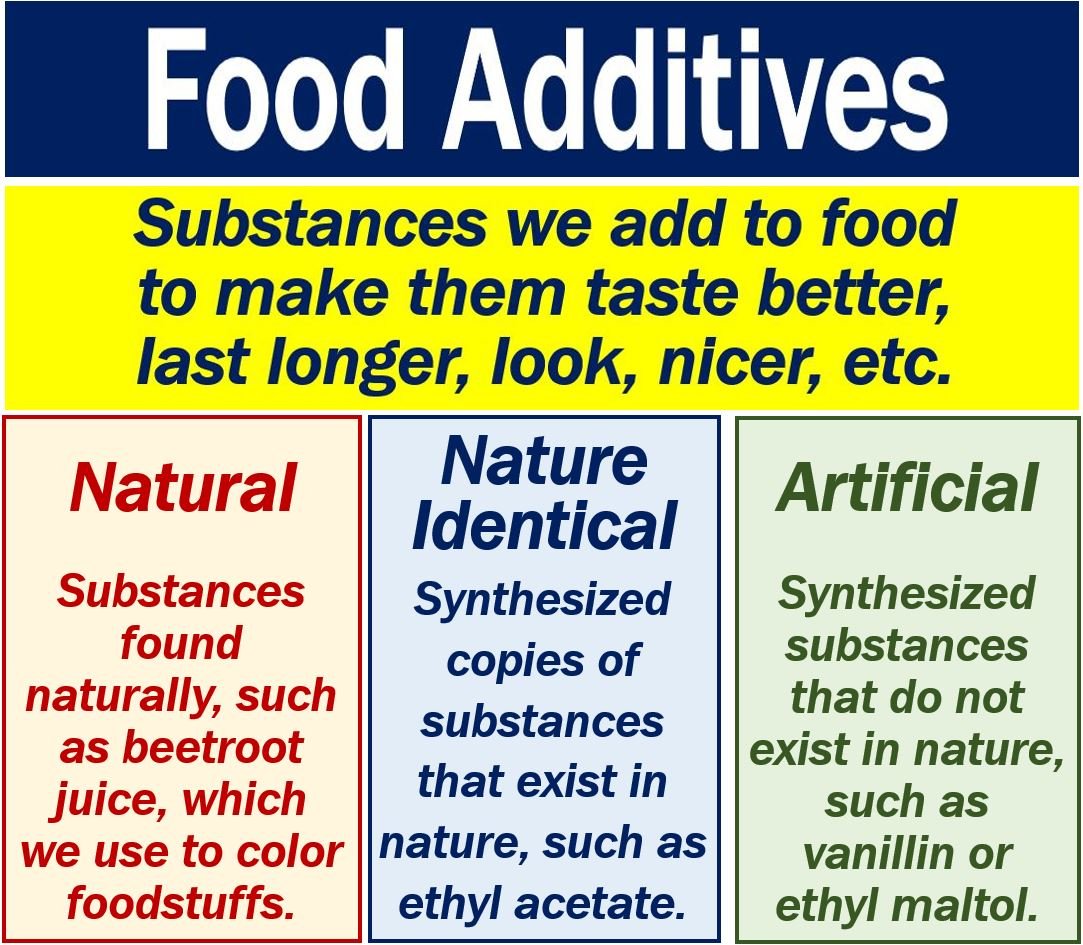What are food additives? Definition and examples
Food additives are substances that we add to food. Specifically, they are functional substances that we add to food in small quantities for one of two reasons: 1. To assist in its processing. 2. To enhance certain features of the food such as its taste, texture, consistency, and color. We may also add them to extend a food’s shelf life.
Regulatory agencies do not consider food additives as nutritional, even if some of them have nutritional value.
We add additives to foods to perform specific functions. Some of them are natural, artificial, or nature identical. Nature identical means that they are synthesized but are chemically identical to their natural counterparts.
Collins Dictionary defines food additives as follows:
“Any of various natural or synthetic substances, such as salt, monosodium glutamate, or citric acid, used in the commercial processing of food as preservatives, antioxidants, emulsifiers, etc., in order to preserve or add flavor, color, or texture to processed food.”
Each country has a regulatory agency that approves or turns down new food additive submissions. In the United States, companies and laboratories submit their applications to the FDA. FDA stands for Food and Drug Administration.

Food additives – three types
A food additive may be natural, artificial, or nature identical.
Natural
These are substances that we find naturally in a foodstuff. We extract them from one food and use them in another.
For example, we use beetroot juice to color some sweets.
Natural identical
These are natural substances that we synthesize, i.e., we produce artificially. Benzoic acid, for example, exists naturally in nature.
We also know how to synthesize benzoic acid. It is cheaper for us to make it than extract it from nature. Therefore, we synthesize it.
Artificial
These food additives do not exist naturally in foods. We synthesize them.
We synthesize, for example, azodicarbonamide. Azodicarbonamide is a flour bleaching agent and a dough conditioner, i.e., it is a flour improver.
Food additives – why use them?
We use food additives for many reasons. Below are some of the reasons:
- To increase the food’s nutritional composition.
- They keep the food safe to eat.
- To maintain the food’s nutrient composition.
- Many food additives extend the storage and shelf life of foods.
- Emulsifiers and some other substances help in the processing and manufacture of some foodstuffs.
Food additives – functions
People in the food industry usually group additives according to their function. Below are the main functions:
Stabilizers, gelling agents, thickeners, and emulsifiers
These additives help in the processing of food. They also help different parts of a foodstuff mix together. Emulsifiers, for example, help oil and water mix together.
Antioxidants
Antioxidants reduce the chance of fats and oils in foods from combining with oxygen. This delays the rate at which foods deteriorate, i.e., go rotten.
Flavor enhancers
Flavor enhancers are common in savory foods, i.e., salty foods. Companies use them to enhance their existing flavor. Monosodium glutamate, for example, is a flavor enhancer.
Sweeteners
Food sellers use bulk or intense sweeteners. Intense sweeteners are super sweet and include substances like aspartame and saccharin.
We add bulk sweeteners in similar amounts to natural sugar.
Colors
Food sellers use color to make their products more appealing and appetizing. Most color additives restore the product’s original color.
Many color additives make a food’s existing color brighter.
The US Food and Drug Administration says the following regarding food additives:
“Additives perform a variety of useful functions in foods that consumers often take for granted.”
“Some additives could be eliminated if we were willing to grow our own food, harvest and grind it, spend many hours cooking and canning, or accept increased risks of food spoilage.”
“But most consumers today rely on the many technological, aesthetic and convenient benefits that additives provide.”

